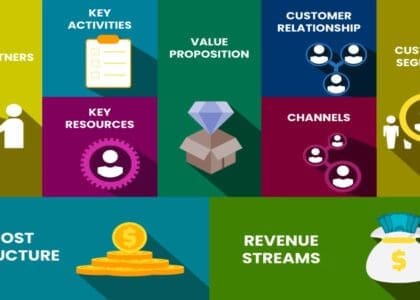A business model is the foundation of any company’s success. It defines how a business creates, delivers, and captures value. Understanding different business models is crucial for entrepreneurs and organizations looking to achieve sustainable growth (Snihur & Markman, 2023). A clear business model helps structure operations, optimize revenue streams, and adapt to market changes (Massa, 2023).
What a Business Model Is: Definition & Key Components
A business model consists of essential elements that outline how a company operates. These include:
- Value Proposition: What problem the business solves and how it delivers unique value.
- Revenue Streams: How the company generates income from customers.
- Key Resources and Activities: The assets and actions needed to operate efficiently.
- Customer Segments and Channels: Who the business serves and how it reaches them (Foss & Saebi, 2018).
A strong business model aligns strategy with financial sustainability, ensuring long-term success (Wirtz & Daiser, 2018).
Type of Business Model: Understanding Different Structures
Businesses operate under various models, including:
- Traditional Models: Brick-and-mortar retail, manufacturing, and franchise businesses.
- Modern Digital Models: E-commerce, software-as-a-service (SaaS), and platform-based economies.
- Industry-Specific Models: Subscription services, marketplace platforms, and direct-to-consumer brands (Lund & Nielsen, 2018).
Each model has unique advantages and challenges, influencing scalability and profitability (Massa, Viscusi & Tucci, 2018).
Example of a Business Model: Real-World Insights
Successful businesses use well-defined models to maximize value. Examples include:
- Amazon: E-commerce and cloud computing service.
- Netflix: Subscription-based streaming model.
- Tesla: Direct-to-consumer and battery technology innovation (Snihur & Zott, 2020).
Case studies illustrate how companies innovate within their models to stay competitive (Foss & Saebi, 2018).
Business Model Canvas (BMC): A Strategic Planning Tool
The Business Model Canvas (BMC) is a visual framework for designing business models. It consists of nine key components:
- Value Proposition
- Customer Segments
- Channels
- Customer Relationships
- Revenue Streams
- Key Resources
- Key Activities
- Key Partnerships
- Cost Structure (Ojasalo & Ojasalo, 2018).
Using BMC enables businesses to map out their models clearly and identify growth opportunities (Taipale-Erävala, Salmela & Lampela, 2020).
Example of a Business Model Canvas: Practical Applications
Businesses use BMC to refine strategies and optimize operations. For instance:
- A startup may use BMC to validate ideas and attract investors.
- An established enterprise might refine its model to expand into new markets (Wit & Dresler, 2021).
BMC provides a dynamic framework for continuous business improvement (Ojasalo & Ojasalo, 2018).
BMC Business Model Canvas: How to Use It Effectively
To implement BMC successfully:
- Define your value proposition clearly.
- Identify your target customers and ideal revenue streams.
- Optimize cost structures and partnerships.
- Continuously test and iterate your model (Possner & Tanaya, 2023).
Avoiding common mistakes, such as overcomplicating the canvas or misaligning customer needs, enhances effectiveness (Wit & Dresler, 2021).
Business Model Subscription: The Rise of Recurring Revenue
Subscription models have gained popularity across industries. Features include:
- Consistent revenue streams through recurring payments.
- Enhanced customer retention by offering ongoing value.
- Scalability by leveraging digital platforms (Wirtz & Daiser, 2018).
Challenges include customer churn and market saturation, requiring businesses to innovate continuously (Taipale-Erävala, Salmela & Lampela, 2020).
Conclusion
Selecting the right business model is vital for long-term success. Whether leveraging traditional models, adopting a business model canvas, or exploring subscriptions, businesses must continuously refine their strategies to remain competitive (Snihur & Markman, 2023). Implementing and adjusting business models based on market trends and customer needs ensures growth and sustainability (Massa, 2023).
References
- Snihur, Y., & Markman, G. (2023). Business Model Research: Past, Present, and Future. Journal of Management Studies. Link
- Massa, L. (2023). The Design of Business Models: What, How and Why. Journal of Business Models, 12(1), 1-10. Link
- Foss, N. J., & Saebi, T. (2018). Business Models and Business Model Innovation: Between Wicked and Paradigmatic Problems. Long Range Planning, 51(1), 9-21. Link
- Wirtz, B. W., & Daiser, P. (2018). Business Model Development: A Customer-Oriented Perspective. Journal of Business Models, 6(3), 24-44. Link
- Ojasalo, J., & Ojasalo, K. (2018). Service Logic Business Model Canvas. Journal of Research in Marketing and Entrepreneurship, 20(1), 70-98. Link
- Taipale-Erävala, K., Salmela, E., & Lampela, H. (2020). Towards a New Business Model Canvas for Platform Businesses in Two-Sided Markets. Journal of Business Models, 8(3), 107-125. Link
- Wit, B., & Dresler, P. (2021). Exploratory Studies of the Business Model Canvas – Differences in the Visualizations of the Business Model. European Research Studies Journal, 24(Special Issue 2), 695-705. Link
- Possner, P. A., & Tanaya, O. (2023). Exploring the Business Model Canvas of Mazars Group: A Comprehensive Analysis. Enrichment: Journal of Management, 13(5), 3348-3358. Link


